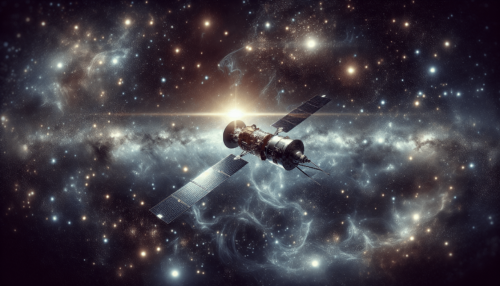Exploring The Universe Through ESA’s Blog : Have you ever wondered what extraordinary stories and cutting-edge advancements lie behind the European Space Agency’s (ESA) missions? ESA’s Blog Navigator provides an extensive library of posts, each giving a unique glimpse into the technical, scientific, and human aspects of space exploration. This wealth of information comes through blog entries from astronauts aboard the International Space Station, reports from specific missions like Rosetta and Mars Express, and updates on initiatives aimed at space sustainability and open access policy.
Table of Contents
ESA’s Blog Navigator: An Overview
The ESA’s Blog Navigator is a crucial medium for disseminating knowledge and updates about the agency’s numerous projects. Its aim is to provide a comprehensive understanding of the ongoing and completed missions, along with insights into the technological challenges and achievements faced by the agency. Whether you’re a professional in the field or an enthusiast, this repository contains valuable information about the intricacies of space exploration.
The Importance of Reliable Information
In an era rife with misinformation and speculative content, ESA’s Blog Navigator stands out for its commitment to providing credible and well-verified information. Every article is meticulously fact-checked, ensuring that the data and stories relayed to the public are reliable and authoritative. This not only builds trust but also helps in educating the masses about the importance and complexity of space missions.
Historical Context: ESA’s Journey Through Time
The European Space Agency, established in 1975, has been monumental in advancing our knowledge of the cosmos. Over the decades, it has launched numerous satellites, probes, and manned missions that have significantly contributed to science. Historically, the ESA has been involved in landmark projects such as the Giotto mission to Halley’s Comet and the Huygens probe’s examination of Titan, a moon of Saturn.
Key Missions That Shaped ESA
Some key missions have notably shaped ESA’s trajectory:
- Rosetta: This mission gave us unprecedented data about comets.
- Mars Express: Offered a detailed map of the Martian surface and a plethora of information about the planet’s atmosphere.
- Gaia: Aimed at cataloging over a billion stars, Gaia is changing our understanding of the Milky Way.
Through these missions, ESA has continually proved its capability and commitment to exploring the unknown.

This image is property of images.pexels.com.
Current Trends in Space Exploration
The trends in space exploration are rapidly evolving with advancements in technology and international collaboration. Emphasis on sustainability, inclusivity, and open-access policies dominate the discourse today. ESA, through its Blog Navigator, is at the forefront of these conversations.
Sustainability Initiatives: Clean Space
One of the most pressing issues currently is space debris. ESA’s Clean Space initiative aims to tackle this problem by developing technologies for debris removal and sustainable satellite design. Through blogs, ESA shares the latest advancements and challenges faced in making space missions more eco-friendly. This initiative reflects a broader trend toward responsible and sustainable space exploration.
Embracing Open Access Policies
Open access to scientific data and research is another significant trend. ESA aims to democratize space research by making its findings accessible to the public and the scientific community. Through its blog, the agency provides in-depth discussions about policies, objectives, and the benefits of open access. This move not only fosters transparency but also accelerates scientific progress by allowing more researchers to utilize and build upon ESA’s data.
Key Concepts and Definitions
Space exploration is a field filled with complex terminology and concepts. Understanding terms like “orbital mechanics,” “astrobiology,” and “spectroscopy” is essential for grasping the nuances of the subject matter.
Orbital Mechanics
Orbital mechanics, or astrodynamics, involves the calculation of the paths taken by objects in space, subject to gravitational forces. This is fundamental for mission planning and navigation, whether sending a satellite into orbit or charting a course for interplanetary travel.
Astrobiology
Astrobiology is the study of the origin, evolution, and potential for life in the universe. Through various missions, ESA seeks to find biosignatures, or signs of life, on other planets and moons. The findings in this field could answer some of humanity’s most profound questions about our place in the universe.
Spectroscopy
Spectroscopy involves examining the light spectrum emitted or absorbed by objects to determine their composition. This method is crucial in identifying the chemical makeup of celestial bodies, which informs us about their history and potential for supporting life.

This image is property of images.pexels.com.
Understanding ESA’s Missions
Breaking down the myriad of tasks undertaken by ESA helps to understand their complexity and significance.
International Space Station Missions
ESA’s contributions to the International Space Station (ISS) are significant. European astronauts, such as Thomas Pesquet and Luca Parmitano, regularly share their experiences and experiments aboard the ISS through blog posts. These entries provide a unique perspective on the daily challenges and triumphs of living and working in space.
For example, Pesquet’s reports detail experiments ranging from fluid dynamics to biological studies in microgravity. These stories bring a human element to the technical data and help readers appreciate the dedication required for such missions.
Rosetta: Unlocking Comet Mysteries
The Rosetta mission, which followed Comet 67P/Churyumov–Gerasimenko, is one of ESA’s most celebrated accomplishments. The mission aimed to understand the fundamental aspects of comet composition and behavior. Detailed blog entries on this mission delve into the intricacies of navigating and landing on a comet, sharing both triumphs and setbacks.
Mars Express: Mapping the Red Planet
Mars Express has been orbiting Mars since 2003, providing a wealth of information about the planet’s surface and atmosphere. The blog posts related to this mission offer an in-depth look at the advanced instruments aboard the spacecraft, such as the High-Resolution Stereo Camera (HRSC), and the groundbreaking findings they have produced.
Case Studies: Successes and Challenges
Examining specific case studies from ESA offers valuable insights into the successes and challenges faced by the agency.
Case Study 1: Successful Deployment of Rosetta
Rosetta’s success is an excellent case study demonstrating ESA’s capabilities. The detailed planning, precise navigation, and data collection efforts have set new benchmarks in space exploration. The mission overcame numerous technical challenges, such as achieving a rendezvous with the comet and deploying the Philae lander.
Case Study 2: Difficulties of the Solar Orbiter Mission
Conversely, the Solar Orbiter mission presents a case of various challenges. Despite the mission’s overall success in providing detailed images of the Sun, it encountered significant obstacles, including dealing with the spacecraft’s exposure to the Sun’s intense radiation. This case study helps understand the complexities and risks inherent in space missions.
Comparing Different Perspectives
To offer a balanced understanding, it’s essential to consider different perspectives on the topics discussed in ESA’s Blog Navigator.
Scientific vs. Engineering Perspectives
Scientists and engineers often approach missions from different angles. Scientists are primarily concerned with the data and its implications, while engineers focus on the feasibility and implementation of technologies. By comparing these perspectives, readers can appreciate the multidimensional nature of space missions.
Public vs. Institutional Viewpoints
Public interest in space exploration is often driven by awe and curiosity, whereas institutions such as ESA focus on scientific objectives and technological advancements. These differing viewpoints occasionally result in varied expectations and evaluations of a mission’s success.
Environmental Impact vs. Technological Advancements
The balance between minimizing environmental impact and pushing technological boundaries is another area of differing viewpoints. While the goal is to make space exploration sustainable, some technological advancements may initially conflict with eco-friendly practices. This comparison highlights the ongoing negotiation between progress and responsibility.
Impact Assessment: The Implications of ESA’s Missions
Analyzing the impact of ESA’s missions helps understand their broader significance and consequences.
Scientific Advancements
ESA’s missions have led to numerous scientific breakthroughs. For instance, the Rosetta mission has substantially increased our understanding of comets, altering theories about the early solar system. Similarly, Mars Express has offered compelling evidence of water’s past presence on Mars, which has significant implications for the possibility of life on the planet.
Technological Innovations
The challenges faced and overcome during these missions have resulted in technological innovations with applications beyond space exploration. Advances in materials science, robotics, and telecommunications, developed for these missions, contribute to progress in other industries.
Societal Influence
ESA’s missions also have a considerable societal impact. They inspire the next generation of scientists and engineers, foster international collaboration, and contribute to educational initiatives. The blog posts often highlight these societal benefits, emphasizing the importance of public engagement and STEM education.

Future Directions and Implications
Looking ahead, several exciting trends and potential developments could shape the future of ESA and space exploration more broadly.
Predictions
Based on current trends, we can predict an era of increased international collaboration and public-private partnerships in space exploration. ESA is likely to play a significant role in missions to the Moon and Mars, including potential human missions. Technological advancements, particularly in AI and robotics, could further enhance mission efficiency and capabilities.
Implications
The continued progress in space exploration will have broader implications for various sectors, including telecommunications, environmental monitoring, and disaster management. The data collected by ESA missions contribute to these fields, underscoring the relevance of space exploration to everyday life on Earth.
In conclusion, ESA’s Blog Navigator serves as an essential resource for anyone interested in the intricacies of space exploration. It provides credible, detailed accounts of the agency’s missions, shedding light on both the scientific and human aspects of space travel. By understanding the historical context, current trends, key concepts, and future implications, readers can gain a comprehensive and balanced perspective.
To summarize today’s discussion, ESA’s Blog Navigator is an invaluable gateway to understanding the extensive efforts involved in space exploration. It provides a credible, detailed platform that educates and inspires, contributing significantly to both science and society. Its detailed coverage ensures that the complexities of space missions are accessible to a wide audience. What are your thoughts on how space exploration can shape our future?
For those interested in learning more about ESA’s missions, consider exploring additional posts within ESA’s Blog Navigator. This wealth of information is not only educational but also inspiring, igniting curiosity and a deeper appreciation for the wonders of the universe.

